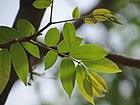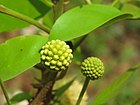Note: This is a project under development. The articles on this wiki are just being initiated and broadly incomplete. You can Help creating new pages.
Difference between revisions of "Xylia xylocarpa"
(→Common names) |
(→Identification) |
||
| (3 intermediate revisions by 2 users not shown) | |||
| Line 1: | Line 1: | ||
| − | + | [[File:Xylia xylocarpa - Burma Ironwood flowers at Peravoor 2018 (3).jpg|thumb|right]] | |
| + | '''Xylia xylocarpa''' is a deciduous tree with a dense crown usually growing 20 - 40 metres tall. The bole is usually straight and cylindrical, sometimes with small buttresses. It can be unbranched for 12 metres or more and around 40 - 60cm in diameter. | ||
==Uses== | ==Uses== | ||
| − | {{Uses|}}, {{Uses|}}, {{Uses|}}, {{Uses|}}, {{Uses|}}, {{Uses|}}, {{Uses|}}, {{Uses|}}, {{Uses| | + | {{Uses|Worms}}, {{Uses|Leprosy}}, {{Uses|Vomiting}}, {{Uses|Diarrhoea}}, {{Uses|Gonorrhoea}}, {{Uses|Ulcers}}, {{Uses|Rheumatism}}, {{Uses|Piles}}, {{Uses|Leprosy}}.<ref name="Uses"/> |
==Parts Used== | ==Parts Used== | ||
| − | {{Parts Used|}}, {{Parts Used| | + | {{Parts Used|Fruits}}, {{Parts Used|Seeds}}. |
==Chemical Composition== | ==Chemical Composition== | ||
| − | <ref name="chemical composition"/> | + | It contains The mature seeds contained 29.5% crude protein, 14.78% crude fat, 8.02% crude fibre, 5.11% ash and 42.6% crude carbohydrates. The seeds appeared to be a good source of potassium, magnesium, phosphorus and iron.<ref name="chemical composition"/> |
==Common names== | ==Common names== | ||
| − | {{Common names|sa=Kanakakuli, Shinshapa|en=Burma ironwood|gu=|hi=Jambu, Jambu|kn=ಬೆಟ್ಟದಾವರಿಕೆ ಮರ Bettadavarike mara, ಹೊನ್ನಾವರಿಕೆ Honnavarike|ks=|ml=Irula, Katamaram|mr=Jambha, Suriya|pa=|ta=Iruvel|te=Boja, Errachennangi}} | + | {{Common names|sa=Kanakakuli, Shinshapa|en=Burma ironwood|gu=|hi=Jambu, Jambu|kn=ಬೆಟ್ಟದಾವರಿಕೆ ಮರ Bettadavarike mara, ಹೊನ್ನಾವರಿಕೆ Honnavarike|ks=|ml=Irula, Katamaram|mr=Jambha, Suriya|pa=|ta=Iruvel|te=Boja, Errachennangi|en= Burma Ironwood, Pyinkado}}.<ref name="Common names"/> |
==Properties== | ==Properties== | ||
| Line 16: | Line 17: | ||
===Dravya=== | ===Dravya=== | ||
===Rasa=== | ===Rasa=== | ||
| − | |||
===Guna=== | ===Guna=== | ||
| Line 29: | Line 29: | ||
==Habit== | ==Habit== | ||
| − | {{Habit|}} | + | {{Habit|Tree}} |
==Identification== | ==Identification== | ||
| Line 36: | Line 36: | ||
===Flower=== | ===Flower=== | ||
| − | {{Flower||||}} | + | {{Flower|||||Flowering from March to October}} |
===Fruit=== | ===Fruit=== | ||
| − | {{Fruit||||||}} | + | {{Fruit||||||Fruiting from March to October}} |
===Other features=== | ===Other features=== | ||
| Line 48: | Line 48: | ||
==Mode of Propagation== | ==Mode of Propagation== | ||
| − | {{Propagation|}} | + | {{Propagation|Seeds}} |
==How to plant/cultivate== | ==How to plant/cultivate== | ||
| − | <ref name="How to plant/cultivate"/> | + | A plant of the moist to wet lowland tropics, occasionally to elevations of 850 metres.<ref name="How to plant/cultivate"/> |
==Commonly seen growing in areas== | ==Commonly seen growing in areas== | ||
| − | {{Commonly seen|}}, {{Commonly seen|}}, {{Commonly seen|}}, {{Commonly seen| | + | {{Commonly seen|Dry evergreen forest}}, {{Commonly seen|Mixed deciduous forest}}, {{Commonly seen|Dry deciduous dipterocarp forest}}, {{Commonly seen|Higher altitude forests}}. |
==Photo Gallery== | ==Photo Gallery== | ||
<gallery class="left" caption="" widths="140px" heights="140px"> | <gallery class="left" caption="" widths="140px" heights="140px"> | ||
| − | + | 02-Xylia xylocarpa 01.JPG | |
| + | 02-Xylia xylocarpa 02.JPG | ||
| + | 02-Xylia xylocarpa 03.JPG | ||
| + | 02-Xylia xylocarpa 04.JPG | ||
| + | 02-Xylia xylocarpa 05.JPG | ||
| + | Xylia xylocarpa - Burma Ironwood flowers at Peravoor 2018 (3).jpg | ||
| + | Xylia xylocarpa - Burma Ironwood flowers at Peravoor 2018 (21).jpg | ||
| + | Xylia xylocarpa 27.JPG | ||
| + | Xylia xylocarpa 34.JPG | ||
</gallery> | </gallery> | ||
| Line 64: | Line 72: | ||
<references> | <references> | ||
| − | <ref name=" | + | <ref name="Common names">[https://sites.google.com/site/indiannamesofplants/via-species/x/xylia-xylocarpa Common names]</ref> |
| + | |||
| + | <ref name="Leaf">[Morphology]</ref> | ||
| − | <ref name=" | + | <ref name="chemical composition">[https://www.sciencedirect.com/science/article/abs/pii/030881469593936L#:~:text=Some%20nutritional%20and%20antinutritional%20characteristics,%2C%20magnesium%2C%20phosphorus%20and%20iron. Chemical constituents]</ref> |
| − | <ref name="How to plant/cultivate">[ | + | <ref name="How to plant/cultivate">[http://tropical.theferns.info/viewtropical.php?id=Xylia+xylocarpa Cultivation]</ref> |
<ref name="Uses">Indian Medicinal Plants by C.P.Khare</ref> | <ref name="Uses">Indian Medicinal Plants by C.P.Khare</ref> | ||
</references> | </references> | ||
==External Links== | ==External Links== | ||
| − | * [ ] | + | * [http://www.flowersofindia.net/catalog/slides/Burma%20Ironwood.html Xylia xylocarpa on flowersofindia.net] |
| − | * [ ] | + | * [https://indiabiodiversity.org/species/show/231524 Xylia xylocarpa on indiabiodiversity.org] |
| − | + | ||
[[Category:Herbs]] | [[Category:Herbs]] | ||
Latest revision as of 11:48, 6 October 2021
Xylia xylocarpa is a deciduous tree with a dense crown usually growing 20 - 40 metres tall. The bole is usually straight and cylindrical, sometimes with small buttresses. It can be unbranched for 12 metres or more and around 40 - 60cm in diameter.
Contents
- 1 Uses
- 2 Parts Used
- 3 Chemical Composition
- 4 Common names
- 5 Properties
- 6 Habit
- 7 Identification
- 8 List of Ayurvedic medicine in which the herb is used
- 9 Where to get the saplings
- 10 Mode of Propagation
- 11 How to plant/cultivate
- 12 Commonly seen growing in areas
- 13 Photo Gallery
- 14 References
- 15 External Links
Uses
Worms, Leprosy, Vomiting, Diarrhoea, Gonorrhoea, Ulcers, Rheumatism, Piles, Leprosy.[1]
Parts Used
Chemical Composition
It contains The mature seeds contained 29.5% crude protein, 14.78% crude fat, 8.02% crude fibre, 5.11% ash and 42.6% crude carbohydrates. The seeds appeared to be a good source of potassium, magnesium, phosphorus and iron.[2]
Common names
| Language | Common name |
|---|---|
| Kannada | ಬೆಟ್ಟದಾವರಿಕೆ ಮರ Bettadavarike mara, ಹೊನ್ನಾವರಿಕೆ Honnavarike |
| Hindi | Jambu, Jambu |
| Malayalam | Irula, Katamaram |
| Tamil | Iruvel |
| Telugu | Boja, Errachennangi |
| Marathi | Jambha, Suriya |
| Gujarathi | |
| Punjabi | |
| Kashmiri | |
| Sanskrit | Kanakakuli, Shinshapa |
| English | Burma Ironwood, Pyinkado |
.[3]
Properties
Reference: Dravya - Substance, Rasa - Taste, Guna - Qualities, Veerya - Potency, Vipaka - Post-digesion effect, Karma - Pharmacological activity, Prabhava - Therepeutics.
Dravya
Rasa
Guna
Veerya
Vipaka
Karma
Prabhava
Habit
Identification
Leaf
| Kind | Shape | Feature |
|---|---|---|
Flower
| Type | Size | Color and composition | Stamen | More information |
|---|---|---|---|---|
| Flowering from March to October |
Fruit
| Type | Size | Mass | Appearance | Seeds | More information |
|---|---|---|---|---|---|
| Fruiting from March to October |
Other features
List of Ayurvedic medicine in which the herb is used
Where to get the saplings
Mode of Propagation
How to plant/cultivate
A plant of the moist to wet lowland tropics, occasionally to elevations of 850 metres.[5]
Commonly seen growing in areas
Dry evergreen forest, Mixed deciduous forest, Dry deciduous dipterocarp forest, Higher altitude forests.
Photo Gallery
References
- ↑ Indian Medicinal Plants by C.P.Khare
- ↑ Chemical constituents
- ↑ Common names
- ↑ [Morphology]
- ↑ Cultivation
External Links
- Pages using duplicate arguments in template calls
- Ayurvedic Herbs known to be helpful to treat Worms
- Ayurvedic Herbs known to be helpful to treat Leprosy
- Ayurvedic Herbs known to be helpful to treat Vomiting
- Ayurvedic Herbs known to be helpful to treat Diarrhoea
- Ayurvedic Herbs known to be helpful to treat Gonorrhoea
- Ayurvedic Herbs known to be helpful to treat Ulcers
- Ayurvedic Herbs known to be helpful to treat Rheumatism
- Ayurvedic Herbs known to be helpful to treat Piles
- Herbs with Fruits used in medicine
- Herbs with Seeds used in medicine
- Herbs with common name in Kannada
- Herbs with common name in Hindi
- Herbs with common name in Malayalam
- Herbs with common name in Tamil
- Herbs with common name in Telugu
- Herbs with common name in Marathi
- Herbs with common name in Sanskrit
- Herbs with common name in English
- Habit - Tree
- Index of Plants which can be propagated by Seeds
- Herbs that are commonly seen in the region of Dry evergreen forest
- Herbs that are commonly seen in the region of Mixed deciduous forest
- Herbs that are commonly seen in the region of Dry deciduous dipterocarp forest
- Herbs that are commonly seen in the region of Higher altitude forests
- Herbs









